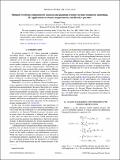Optimal waveform estimation for classical and quantum systems via time-symmetric smoothing. II. Applications to atomic magnetometry and Hardy's paradox
Author(s)
Tsang, Mankei
DownloadTsang-2010-Optimal waveform estimation for classical and quantum systems via time-symmetric smoothing.pdf (370.7Kb)
PUBLISHER_POLICY
Publisher Policy
Article is made available in accordance with the publisher's policy and may be subject to US copyright law. Please refer to the publisher's site for terms of use.
Terms of use
Metadata
Show full item recordAbstract
The time-symmetric quantum smoothing theory [Tsang, Phys. Rev. Lett. 102, 250403 (2009); Phys. Rev. A 80, 033840 (2009)] is extended to account for discrete jumps in the classical random process to be estimated, discrete variables in the quantum system, such as spin, angular momentum, and photon number, and Poisson measurements, such as photon counting. The extended theory is used to model atomic magnetometers and study Hardy’s paradox in phase space.
Date issued
2010-01Department
Massachusetts Institute of Technology. Research Laboratory of ElectronicsJournal
Physical Review A
Publisher
American Physical Society
Citation
Tsang, Mankei. “Optimal waveform estimation for classical and quantum systems via time-symmetric smoothing. II. Applications to atomic magnetometry and Hardy's paradox.” Physical Review A 81.1 (2010): 013824. © 2010 The American Physical Society.
Version: Final published version
ISSN
1050-2947